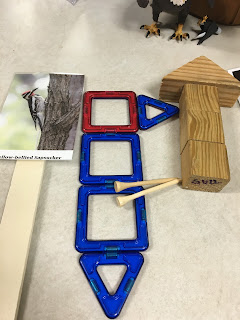Attractions inside varied. There was a huge wind tunnel you could actually go inside, with various fabrics to try them out in the wind. The butterfly wings and kites were cool, though they really just liked all the wind! There was also a large screen that senses where your body is to interact with the scenario. In this screen, our arms became large birds finding food. I assume they can change out the screen to keep the area fresh.
It was interesting to see their "snow" as we are typically used to plenty of snow in northern Indiana. This open invitation included simple cotton balls and tape. Changing things up slightly like this gives additional ways to interact. Additionally, they had white soft balls that served for snowball fights. When there isn't snow around, you learn to get creative, right?
The outdoor space was inviting with some adventure, such as this rope bridge. The youngest did great on it.
There was also a huge "water table on steroids" equivalent. My youngest would have been here the whole time if he could have, even though the water was closed down, perhaps for the season. There were balls, boats, and many ways to explore how water works.
This was part of the climbing fort. I love seeing lots of wood. Additionally, there was whole section of logs at various angles to climb. They had fun, despite the funny faces! One thing I missed in this section was loose parts. I'm a huge proponent to loose parts and love to see opportunities to build, create, and make something new in the environment.
There was a small hill, plants, and trees nearby. The grass was artificial--wonder if it's hard to grow there or it just gets too much use there?
Inside, the museum had a whole are for younger children to promote dramatic play. The airplane allowed you to be captain, passenger, baggage handler, etc. It was interesting to see how much they enjoyed doing x-rays on the luggage! Simple props like a captain's jacket helped facilitate the play. In the veterinarian's station there were several ways to investigate the animals in their care, such as stuffed animals, cages, clipboards with patient sheets, band-aids, scrubs, and more. They also had a little post office, construction area, grocery store, eatery, gas station with car, etc. This was all enclosed with an attendant at the front so kids didn't wander off on their own; however, all the children I saw were actively engaged with all the options for dramatic play!
Another section for the older kids included Spy Kids--learning how to be a spy. They learned secret codes, storytelling, geometry, problem solving, and more.
Another exhibit focused on light and sound, with some homemade options using found objects and mallets to create interesting sounds. The whole exhibit (not much is pictured) allowed you to be a DJ mix master and see how sound affects and interacts with us, even the sounds of nature. You could use mirrors to manipulate light, too.
On the other side of the building was a cool tree house with nearby gardens and "stream". There were plenty of plants and inviting spaces to enjoy the outdoors. You could wade in the stream, sail boats down in, and more.
Our kids kept trying to make dams (it was his science fair project, too!), but I don't think they were very effective. Glad there were some loose parts in these areas.
The whole area was aesthetically pleasing and designed with children in mind, giving safe places to explore.
The sand pit with conveyer belt was another favorite!
Upstairs had a tinkering space, called Innovation Station. Love the name! The website describes it as, "Children are encouraged to evaluate, try, fail, re-evaluate and try again. Innovation Station appeals to multiple types of intelligences and eschews lengthy instructions for more intuitive learning."
Yes! We loved the wind tunnels--we need one of these closer! I've been investigating DIY options, but haven't been able to source the acetate to make one yet. I like how they included the design process.
This whole area had lots of loose parts to try various options in the wind tunnel and/or to build something with blocks.
There were also options to try ramps and balls. You could change and tinker with the options.
There was more! They had areas with tables so different activities could be put out for special events or themes. There was a large room with maps (including huge state pieces to put together!) and ways to interact with our global outreach. There was a video screen hooked up to a museum in Mexico where we could use a white board to talk to someone there. My Spanish skills came in handy! ;-) There was a multipurpose area that was used for snowball fights and an icy wonderland, but it was closed when we were there. I assume they change what is here often. There was also an imaginative area that had "caves" and "nests" that left lots to the imagination. This also could easily have costumes and such changed out for a different feel to the space. There was a section with tubes and balls the children enjoyed manipulating as well. It's great visiting spaces that help us Learn, Create, and Explore!





















































































